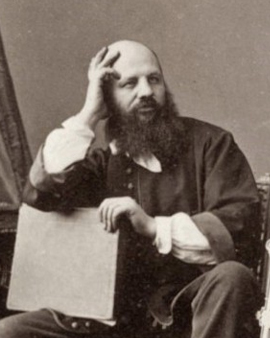André Adolphe-Eugène Disdéri had actually aspired to a career as an artist. He studied painting, but with moderate success. He then tried his hand as an actor in a theater troupe and showed real talent. But the early death of his father, who had financed his dreams, forced him to suppress his ambitions and provide for the family. In order to provide for his mother, his siblings and, of course, his wife Geneviève Elizabeth and his own children, he went into the business world instead of the stage. However, he never completely let go of the creative side of things. And as soon as he had the means together, he opened his first photo studio in Brest in 1847 - fascinated by the new technology and its possibilities. Four years later, he opened another studio for art photography. Disdéri primarily used the so-called daguerreotype, the first commercially viable photographic process of its time. Soon, however, he also used the wet collodion process, which had not been developed for long, and not only for portraits. He liked to experiment with subjects and also captured groups of beggars and ragpickers, athletes and workers, landscapes and animals.
In 1854 André Adolphe-Eugène Disdéri became the owner of the largest photo studio in Paris. In general, this year was to be his year: It was also the year he developed the "Carte de Visite," a process he patented. It made it possible to take a series of eight portrait pictures on collodion negative material and with the help of a multi-lens camera. The resulting photographs, which also allowed variations in pose, were mounted on cardboard and cut out to business card size. Thus, they could be presented like a business card in business or given to family and friends as a gift or collector's item. The process devised by André Adolphe-Eugène Disdéri was soon to displace all older techniques in commercial portrait photography and earn him a great deal of money. However, the inventor went through a financial lean period before this happened. The Parisian businessman had to declare bankruptcy in 1856 and sell his studio. In general, his career was not accompanied by lasting financial success. He died blind, deaf and penniless. Before that, however, he invented the so-called mosaic picture. It made it possible to combine photos of different people or various views of an object into a single photograph.
Disdéri's photographs are today popular exchange and collector's items. Even major international museums keep "Carte de Visite" originals and mosaic images. They can be found at the Haus der Kunst in Munich, the Musée d'Orsay in Paris, and the National Galleries of Scotland, among others. However, some of André Adolphe-Eugène Disdéri's works also have historical significance and have gone down in the history books: For example, he photographed during the Paris Commune uprising of 1871 and captured, among other things, the Paris Communards overthrowing the Colonne Vendôme.
×





.jpg)
.jpg)
_-_circa_1865_-_Digital_c_-_(MeisterDrucke-917185).jpg)
_-_circa_1865_-_Digital_c_-_(MeisterDrucke-917185).jpg)
 - (MeisterDrucke-164870).jpg)
 - (MeisterDrucke-164870).jpg)
_-_(MeisterDrucke-1649701).jpg)
_-_(MeisterDrucke-1649701).jpg)
_-_(MeisterDrucke-1650039).jpg)
_-_(MeisterDrucke-1650039).jpg)
_-_(MeisterDrucke-1648534).jpg)
_-_(MeisterDrucke-1648534).jpg)
_-_(MeisterDrucke-1650038).jpg)
_-_(MeisterDrucke-1650038).jpg)
_-_(MeisterDrucke-1648562).jpg)
_-_(MeisterDrucke-1648562).jpg)
_-_(MeisterDrucke-1649038).jpg)
_-_(MeisterDrucke-1649038).jpg)
.jpg)
.jpg)
.jpg)
.jpg)
_-_(MeisterDrucke-1648535).jpg)
_-_(MeisterDrucke-1648535).jpg)
_-_(MeisterDrucke-1648224).jpg)
_-_(MeisterDrucke-1648224).jpg)
_-_(MeisterDrucke-1648222).jpg)
_-_(MeisterDrucke-1648222).jpg)
_-_(MeisterDrucke-1648223).jpg)
_-_(MeisterDrucke-1648223).jpg)
.jpg)
.jpg)
.jpg)
.jpg)
_-_(MeisterDrucke-1648516).jpg)
_-_(MeisterDrucke-1648516).jpg)
.jpg)
.jpg)
.jpg)
.jpg)
.jpg)
.jpg)
.jpg)
.jpg)
.jpg)
.jpg)
.jpg)
.jpg)
.jpg)
.jpg)
 - (MeisterDrucke-190634).jpg)
 - (MeisterDrucke-190634).jpg)
_in_town_costume_-_(MeisterDrucke-1057556).jpg)
_in_town_costume_-_(MeisterDrucke-1057556).jpg)
_-_(MeisterDrucke-1559913).jpg)
_-_(MeisterDrucke-1559913).jpg)
.jpg)
.jpg)
.jpg)
.jpg)
.jpg)
.jpg)
_-_(MeisterDrucke-1051604).jpg)
_-_(MeisterDrucke-1051604).jpg)
.jpg)
.jpg)
.jpg)
.jpg)
.jpg)
.jpg)
.jpg)
.jpg)
.jpg)
.jpg)
.jpg)
.jpg)
.jpg)
.jpg)
.jpg)
.jpg)
.jpg)
.jpg)
_-_(MeisterDrucke-1540487).jpg)
_-_(MeisterDrucke-1540487).jpg)
 - (MeisterDrucke-91120).jpg)
 - (MeisterDrucke-91120).jpg)
.jpg)
.jpg)
.jpg)
.jpg)
_-_(MeisterDrucke-1051729).jpg)
_-_(MeisterDrucke-1051729).jpg)
.jpg)
.jpg)
.jpg)
.jpg)
.jpg)
.jpg)
.jpg)
.jpg)
.jpg)
.jpg)
_in_town_costume_-_(MeisterDrucke-1054271).jpg)
_in_town_costume_-_(MeisterDrucke-1054271).jpg)
.jpg)
.jpg)
.jpg)
.jpg)
.jpg)
.jpg)
_-_(MeisterDrucke-1542937).jpg)
_-_(MeisterDrucke-1542937).jpg)
_in_stage_co_-_(MeisterDrucke-1052210).jpg)
_in_stage_co_-_(MeisterDrucke-1052210).jpg)
_-_(MeisterDrucke-1052691).jpg)
_-_(MeisterDrucke-1052691).jpg)
.jpg)
.jpg)
_in_town_costume_-_(MeisterDrucke-1054272).jpg)
_in_town_costume_-_(MeisterDrucke-1054272).jpg)
.jpg)
.jpg)
.jpg)
.jpg)
.jpg)
.jpg)
 Bonheur with three unknown family membe - (MeisterDrucke-369511).jpg)
 Bonheur with three unknown family membe - (MeisterDrucke-369511).jpg)
_-_(MeisterDrucke-993146).jpg)
_-_(MeisterDrucke-993146).jpg)
.jpg)
.jpg)
.jpg)
.jpg)
.jpg)
.jpg)
.jpg)
.jpg)
.jpg)
.jpg)
_-_(MeisterDrucke-1592046).jpg)
_-_(MeisterDrucke-1592046).jpg)
.jpg)
.jpg)
.jpg)
.jpg)
.jpg)
.jpg)
.jpg)
.jpg)
.jpg)
.jpg)
.jpg)
.jpg)
.jpg)
.jpg)
.jpg)
.jpg)
.jpg)
.jpg)
_Photography_by_Disderi_-_(MeisterDrucke-1051310).jpg)
_Photography_by_Disderi_-_(MeisterDrucke-1051310).jpg)
.jpg)
.jpg)
.jpg)
.jpg)
.jpg)
.jpg)
.jpg)
.jpg)
.jpg)
.jpg)
_photographied_between_1880-1895_extracted_fr_-_(MeisterDrucke-1473424).jpg)
_photographied_between_1880-1895_extracted_fr_-_(MeisterDrucke-1473424).jpg)
.jpg)
.jpg)
.jpg)
.jpg)
.jpg)
.jpg)
.jpg)
.jpg)
.jpg)
.jpg)
![Duchess of Morny [née Troubetskoi, Illegitimate Daughter of Nicholas I] by Andre Adolphe Eugene Disderi Duchess of Morny [née Troubetskoi, Illegitimate Daughter of Nicholas I] by Andre Adolphe Eugene Disderi](/kunstwerke/300px/Andre_Adolphe_Eugene_Disderi_-_Duchesse_de_Morny_nee_Troubetskoi_illegitimate_daughter_of_Nicholas_I_-_(MeisterDrucke-1588657).jpg)
![Duchess of Morny [née Troubetskoi, Illegitimate Daughter of Nicholas I] by Andre Adolphe Eugene Disderi](/kunstwerke/400w/Andre_Adolphe_Eugene_Disderi_-_Duchesse_de_Morny_nee_Troubetskoi_illegitimate_daughter_of_Nicholas_I_-_(MeisterDrucke-1588657).jpg)
.jpg)
.jpg)
.jpg)
.jpg)
.jpg)
.jpg)
.jpg)
.jpg)
_-_(MeisterDrucke-1556953).jpg)
_-_(MeisterDrucke-1556953).jpg)
.jpg)
.jpg)
.jpg)
.jpg)






